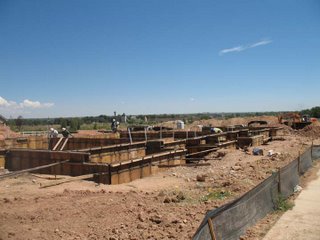
Last weekend, my family and I went camping up around Aspen. So on one of the days, I took a trip to Aspen to see what was going on, and of course, I had to drive by my Grandma's (on my fathers side) first house she owned with her husband. A few years ago, the current owners did a major remodel and addition to the home. This isn't unusual for Aspen, as the town is famous for tear downs and McMansions.
Anyway, I was very impressed how the owners preserved the original house, and only added onto the rear of the house. From the street, you can hardly tell they added on. I felt that this showed a lot of restraint and respect for the history of architecture. Now my grandparents only owned this house for a few short years, but my family has a long history in Aspen and Snowmass. Can you believe, that my grandparents originally bought this house in 1935 (or so) including 5 city lots, overlooking a lake, for about $2,000? Of course, in those days, lakes were viewed as dumps.
Back in 1985, I took my grandma to Aspen as part of her 50th wedding anniversary. Unfortunately, my grandfather died a couple of years before. Anyway, we had the good fortune of running into the owner of the property at that time who was a retired lawyer from Chicago, who had owned the home for about 30 years. He was very happy to see us and knew who my grandma was! He showed us all around the property, and I was very fortunate to see the house. This is the same house my father was born in. On that trip, I was able to see the house where my grandma was raised, and the one she was born in! That home was vacant at the time and probably does not exist now.
The resort of Snowmass (the base village), was originally our family ranch. My grandfather was born on that ranch. Of course, the family sold it before it ever became the resort. But on that one, they preserved our original homestead and turned it into the Snowmass arts center! I was able to see the house where my grandpa was born, and the old barn. That facility is now known as the Anderson ranch. It obtained that name when my grandpa and his brother walked off the ranch one day, never to return. The ranch then went to there sister Hildur, who married a gent by the name of Bill Anderson, and the rest, they say, is history.










